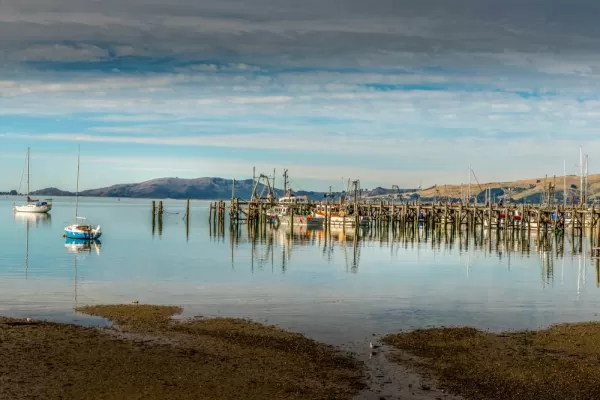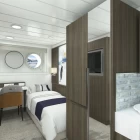It's almost impossible to describe the feeling of arriving in Antarctica's storied, icebound sector. Stepping outside and taking a deep breath of some of the most fresh, crisp air on earth is an experience to cherish forever.
The Ross Sea region is a globally significant wildlife sanctuary. Its nutrient-rich waters support an astonishing array of uniquely adapted Antarctic species, including Ross Sea orcas, Antarctic petrels, and South Pacific Weddell seals. It is also home to Antarctica's largest Adélie penguin colony and many of the largest emperor penguin colonies. The unique biodiversity of the Ross Sea has been protected within the world's largest marine protected area since 2016.
The human heritage of the Ross Sea coast is equally impressive. Since James Clark Ross discovered the region in 1841, countless expeditions have built base camps on scattered ice-free slivers of land, using them as staging posts for bold forays across the polar plateau. Many departed in a hurry, leaving artifacts, scientific equipment, and sometimes entire huts behind. Today, these sites are preserved as open-air museums and are protected under the Antarctic Treaty System.
Embrace the spirit of exploration as your expedition team designs your voyage daily, bringing decades of experience to selecting the ideal sites based on the prevailing weather, ice conditions, and wildlife opportunities.
Some places you may visit include:
Ross Ice Shelf
Find a spot on deck as you cruise perfectly cleaved ice cliffs towering some 30 meters above the crystalline waters of the Ross Sea. This is the floating edge of the largest ice shelf in Antarctica, which covers an area the size of France. Watch for elegant emperor penguins, sweet-faced Weddell seals hauled out on ice floes, and the unmistakable 'pouf' of an orca's exhalation.
Franklin Island
This delightful ice-free outpost with a rookery of rambunctious Adélie penguins is well worth a visit. Stretch your legs as you stroll up a gentle incline past the colony to a high point, where panoramic views of the Ross archipelago and the ice shelf unfurl.
McMurdo Sound
Enter a realm of exquisite beauty, an otherworldly icescape set against a backdrop of gleaming glaciers, shimmering mountains, and the polar ice sheet itself. McMurdo Sound is the historic gateway to the South Pole. It remains a busy working harbor today, serving as a logistics hub for the extensive scientific operations at the McMurdo and Scott Research bases on Ross Island.
In this achingly barren landscape, early explorers established their base camps and struck out for the South Pole. If conditions allow, you aim to land at one (or more) of their beautifully preserved huts, many of which still stand, to dwell for a moment amongst the artifacts of a distant time and reflect on the triumphs and tragedies of those who brought them here.
Cape Washington, Terra Nova Bay
Bounded by soaring peaks and fed by immense glaciers, Terra Nova Bay supports an abundance of polar wildlife, including the rarely sighted Arnoux's Beaked Whale. Fast ice anchored to the bay's northern shore in the shelter of Cape Washington is home to one of the largest known emperor penguin colonies. Some 20,000 males huddle here each winter, incubating their eggs and awaiting the sun's return. Weather and ice permitting, visit the bustling rookery to witness the delightful emperors and their fledging chicks.
Cape Hallett
The snow-capped Admiralty Mountains rise dramatically from the gravelly spit of Cape Hallett, where you hope to land. This is the site of a decommissioned scientific base and an abundance of Antarctic mosses, lichens, and invertebrates protected by the Antarctic Treaty System.
Amble across gently undulating terrain, giving resting Weddell seals a wide berth. The Adélie penguin rookery here can host nearly 50,000 breeding pairs, while snow petrels, Wilson's storm petrels, and South Polar skuas breed in the rocky crevices nearby.
Cape Hallett also has a special significance for Aurora. From this rocky foothold, Greg Mortimer, co-founder of Aurora Expeditions, launched the Australian Bicentennial Antarctic Expedition in 1988. Cape Hallett provided access to the glaciated coastal ranges beyond, where the six-man team completed the first ascent of Mt Minto (4,165 meters).
Cape Adare
Cape Adare lies 100 km (62 miles) north of Cape Hallet, at the western entrance to the Ross Sea. A rare ice-free refuge on this icebound coastline, Cape Adare is home to Antarctica's largest Adélie penguin colony. Ice and weather permitting, wend your way through the pack ice to land on the flat, cobbled spit where more than 250,000 breeding pairs of Adélies gather to busily breed, feed, and raise their chicks in the short southern summer.
First visited by James Clark Ross in 1841, this rocky promontory played an important role in the pioneering expeditions of the Heroic Age of Antarctic exploration. It was here in 1899 that the Southern Cross expedition, led by Carsten Borchgrevink, became the first to winter over in Antarctica and establish the first human structures on the continent.
The remnants of these pioneering constructions and thousands of artifacts scattered in their vicinity remain virtually untouched and protected under the Antarctic Treaty System. You hope to enter Borchgrevink's living quarters to experience the awe and imagine the perils of conducting science here, as they did through an Antarctic winter.






























